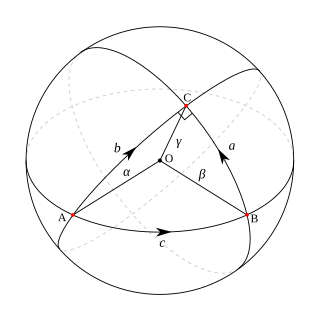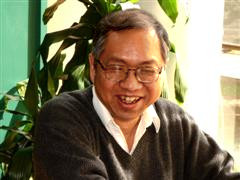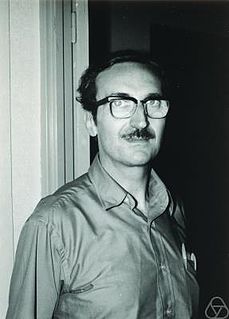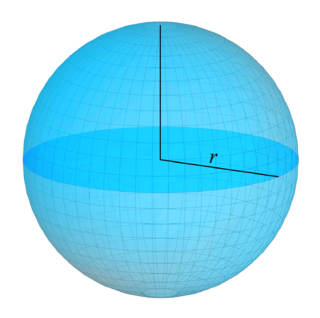Related Research Articles

Algebraic geometry is a branch of mathematics, classically studying zeros of multivariate polynomials. Modern algebraic geometry is based on the use of abstract algebraic techniques, mainly from commutative algebra, for solving geometrical problems about these sets of zeros.

In classical mathematics, analytic geometry, also known as coordinate geometry or Cartesian geometry, is the study of geometry using a coordinate system. This contrasts with synthetic geometry.

In geometry, a geodesic is commonly a curve representing in some sense the shortest path (arc) between two points in a surface, or more generally in a Riemannian manifold. The term also has meaning in any differentiable manifold with a connection. It is a generalization of the notion of a "straight line" to a more general setting.
In mathematics, a quadric or quadric surface, is a generalization of conic sections. It is a hypersurface in a (D + 1)-dimensional space, and it is defined as the zero set of an irreducible polynomial of degree two in D + 1 variables. When the defining polynomial is not absolutely irreducible, the zero set is generally not considered a quadric, although it is often called a degenerate quadric or a reducible quadric.

Riemannian geometry is the branch of differential geometry that studies Riemannian manifolds, smooth manifolds with a Riemannian metric, i.e. with an inner product on the tangent space at each point that varies smoothly from point to point. This gives, in particular, local notions of angle, length of curves, surface area and volume. From those, some other global quantities can be derived by integrating local contributions.

In differential geometry, the Gaussian curvature or Gauss curvatureΚ of a surface at a point is the product of the principal curvatures, κ1 and κ2, at the given point:

In mathematics, an affine space is a geometric structure that generalizes some of the properties of Euclidean spaces in such a way that these are independent of the concepts of distance and measure of angles, keeping only the properties related to parallelism and ratio of lengths for parallel line segments.

Shing-Tung Yau is an American mathematician and the William Caspar Graustein Professor of Mathematics at Harvard University.

Eugenio Calabi is an Italian-born American mathematician and the Thomas A. Scott Professor of Mathematics, Emeritus, at the University of Pennsylvania, specializing in differential geometry, partial differential equations and their applications.
In mathematics, the canonical bundle of a non-singular algebraic variety of dimension over a field is the line bundle , which is the nth exterior power of the cotangent bundle Ω on V.

Three-dimensional space is a geometric setting in which three values are required to determine the position of an element. This is the informal meaning of the term dimension.
Aleksei Vasil'evich Pogorelov, was a Soviet and Ukrainian mathematician. Specialist in the field of convex and differential geometry, geometric PDEs and elastic shells theory, the author of the novel school textbook on geometry and university textbooks on analytical geometry, on differential geometry, and on foundations of geometry.

In mathematics, a surface is a generalization of a plane, which is not necessarily flat – that is, the curvature is not necessarily zero. This is analogous to a curve generalizing a straight line. There are many more precise definitions, depending on the context and the mathematical tools that are used to analyze the surface.

Luís Antoni Santaló Sors was a Spanish mathematician.
In Riemannian geometry, an isoparametric manifold is a type of (immersed) submanifold of Euclidean space whose normal bundle is flat and whose principal curvatures are constant along any parallel normal vector field. The set of isoparametric manifolds is stable under the mean curvature flow.

Lie sphere geometry is a geometrical theory of planar or spatial geometry in which the fundamental concept is the circle or sphere. It was introduced by Sophus Lie in the nineteenth century. The main idea which leads to Lie sphere geometry is that lines should be regarded as circles of infinite radius and that points in the plane should be regarded as circles of zero radius.
In differential geometry, the Carathéodory conjecture is a mathematical conjecture attributed to Constantin Carathéodory by Hans Ludwig Hamburger in a session of the Berlin Mathematical Society in 1924. Carathéodory did publish a paper on a related subject, but never committed the Conjecture into writing. In, John Edensor Littlewood mentions the Conjecture and Hamburger's contribution as an example of a mathematical claim that is easy to state but difficult to prove. Dirk Struik describes in the formal analogy of the Conjecture with the Four Vertex Theorem for plane curves. Modern references to the Conjecture are the problem list of Shing-Tung Yau, the books of Marcel Berger, as well as the books.

Edward Kasner was a prominent American mathematician who was appointed Tutor on Mathematics in the Columbia University Mathematics Department. Kasner was the first Jew appointed to a faculty position in the sciences at Columbia University. Subsequently, he became an adjunct professor in 1906, and a full professor in 1910, at the university. Differential geometry was his main field of study. In addition to introducing the term "googol", he is known also for the Kasner metric and the Kasner polygon.

In geometry, a motion is an isometry of a metric space. For instance, a plane equipped with the Euclidean distance metric is a metric space in which a mapping associating congruent figures is a motion. More generally, the term motion is a synonym for surjective isometry in metric geometry, including elliptic geometry and hyperbolic geometry. In the latter case, hyperbolic motions provide an approach to the subject for beginners.
References
- 1 2 Shikin, E. V. (2001) [1994], "Affine sphere", Encyclopedia of Mathematics , EMS Press
- ↑ "Google Scholar Search". Google Inc.
- ↑ Buchin, S. (1983). Affine differential geometry . Sci. Press and Gordon & Breach. ISBN 0-677-31060-9.
- ↑ Ishikawa, G.; Machida, Y. (2005). "Singularities of improper affine spheres and surfaces of constant Gaussian curvature". arXiv: math/0502154 . Bibcode:2005math......2154I.Cite journal requires
|journal=(help)
| | This differential geometry related article is a stub. You can help Wikipedia by expanding it. |